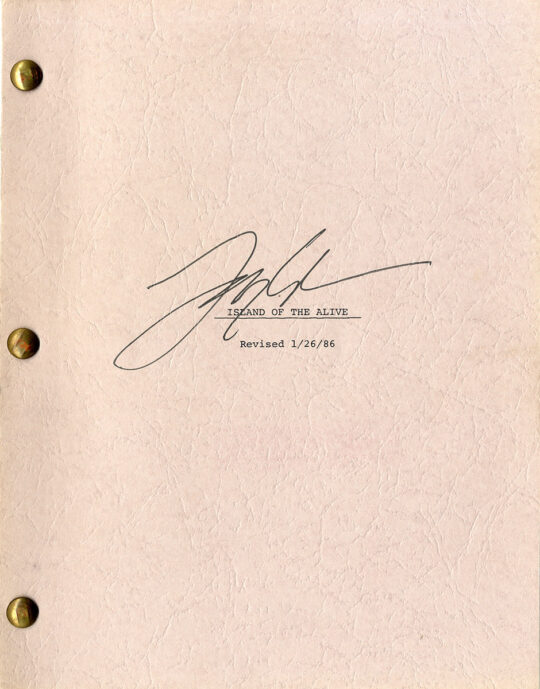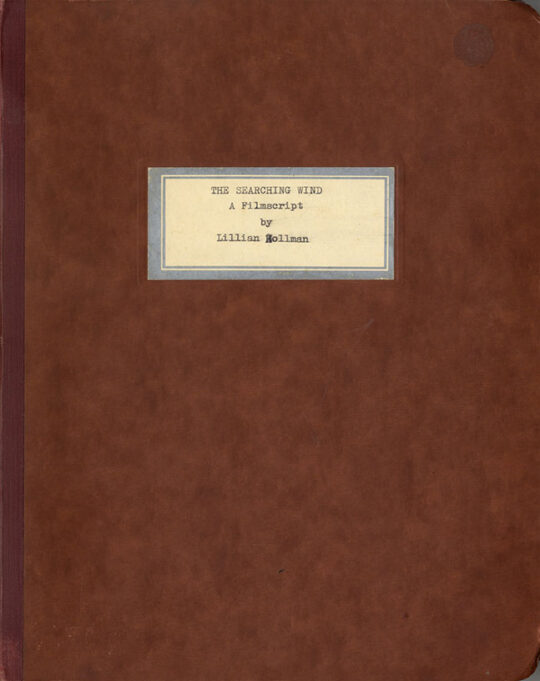WINGS OF EAGLES, THE (1957) Two variant film scripts
John Ford (director) Frank Fenton (screenwriter) Culver City: Metro-Goldwyn-Mayer, 21 July – 4 October 1955 and 20 February – 11 July [rerun 27 July] 1956. Two volumes. 116 leaves, plus duplicate leaf 116 printing variant text; and [1],123 leaves, plus lettered inserts. Quarto. The first comprised of carbon typescript on yellow paper (with each leaf marked ‘Permanent Script File’ in red), and mimeographed typescript, text on rectos only. Bradbound in studio wrappers, with studio labels and stamps. A few fore-edges in first script extended and slightly frayed; faint discoloration to fore-edge at toe of second script, otherwise very good or better, the first stamped “Vault Copy”.
Two widely differing drafts of the script for John Ford’s 1957 film about the development of Naval aviation, and semi-biographical tribute to his friend, Navy flier turned screenwriter Frank W. “Spig” Wead. John Wayne was cast as Wead, and Dan Dailey, Maureen O’Hara and Ward Bond co-starred. Fenton shared final screen credit with William W. Haines for the script, but at this point in the creative process, Fenton is the sole identified screenwriter. A table inside the frontwrapper of the second draft records in manuscript some of the dated revisions over the span noted above.
Frank Fenton (1903-1971) was a veteran novelist and screenwriter whose prolific and versatile movie career, beginning in 1932 and ending in 1959, includes writing or co-writing the screenplays of NOCTURNE (1946), STATION WEST (1948), MALAYA (1949), WALK SOFTLY STRANGER (1950), HIS KIND OF WOMAN (1949), THE MAN WITH A CLOAK (1951), ESCAPE FROM FORT BRAVO (1953), RIVER OF NO RETURN (1954), GARDEN OF EVIL (1954), UNTAMED (1955), and THE JAYHAWKERS! (1959), after which he continued to write for television.
However, this was the only screenplay Fenton ever wrote that was about another screenwriter, specifically, Commander Frank W. “Spig” Wead, whose own screenplay credits include HELL DIVERS (1931), CEILING ZERO (1936, based on his own Broadway play), and THEY WERE EXPENDABLE (1945), the latter directed by John Ford, who also directed THE WINGS OF EAGLES and appears in Fenton’s screenplays and the movie as John Dodge (played in the movie by Ward Bond).
The result is a genre mash-up, mostly a military film/biopic about Wead’s life in the Navy, but also to some degree a Hollywood story, manically veering from broad comedy to grim tragedy and back again. John Wayne (who also starred in THEY WERE EXPENDABLE) plays Spig Wead. Maureen O’Hara is cast as Min, his neglected wife.
This is one of director Ford’s oddest and most personal films. On the surface, it’s a tribute to a career naval pilot who, as Wikipedia puts it, “tries to prove to the Navy the value of aviation in combat.” Beneath that surface narrative, it’s the far more interesting story of a man who clearly prefers the homosocial military world — drinking, flying planes and brawling with his Army and Navy buddies — to the heterosexual world of wife and family. (There are three such brawls in the movie’s first 40 minutes.) Significantly, at the exact point in the story when Wead attempts a reconciliation with his wife, he falls down the stairs of their home and breaks his neck, paralyzing himself. Wead’s paralysis becomes a metaphor for domestic entrapment. And who sees him through his convalescence and rehabilitation after he is paralyzed? Not his wife, but his best Navy pal, “Jughead” Carson, played by Dan Dailey.
As Joseph McBride observes in his biographical study, SEARCHING FOR JOHN FORD (St. Martin’s Press, 1999):
“Carson seems totally devoted to Wead, almost as if in an unspoken homosexual attachment, and becomes more of a ‘wife’ to Wead than Min ever manages to be.“
Even if we ignore the presence of Ford as a character in his own movie, the film’s parallels to Ford’s own life are unmistakable. Ford, like Wead, was both a Hollywood professional and a military man — he served as an Admiral in the Navy during World War II — who plainly preferred the predominantly male worlds depicted in his Westerns and military films to the male/female world of regular civilian life. The last act of Wead’s life — physically disabled, but honored by his peers for his military accomplishments — mirrors the latter part of Ford’s life, impaired by alcoholism, most likely sexually impotent, but universally honored for his cinematic accomplishments and service to the nation.
The Two Fenton Scripts
Fenton’s 2/20/56 script is considerably more polished than his 7/21/55 draft and may have been the final or close-to-final shooting script. Although these two scripts are credited to Frank Fenton, alone, on screen the movie’s screenplay is credited to Frank Fenton and William Wister Haines, another veteran screenwriter (COMMAND DECISION). Whatever Haines’ contribution might have been, it most likely preceded Fenton’s, since Fenton’s 2/20/56 script is very close to the completed film.
The principal difference between the first acts of the two Fenton scripts is in the sequence where Spig, without authorization, flies and crashes a seaplane during his first solo flight. In the 7/21/55 draft, he crashes the plane into the ocean. In the 2/20/56 script, Spig disrupts the Admiral’s Tea Party, which his wife Min is attending, crashing the plane into the Admiral’s swimming pool. The film, unlike either of these two drafts, opens with a brief voiceover narration by one of Spig’s fellow officers, John Dale Price (Ken Curtis).
The 2/20/56 draft adds another crony for Spig, Second Mechanic Pincus (Tige Andrews).
The second act of both scripts, ending with Spig’s accident, contains a scene where Spig fires his former flying instructor. This scene is omitted from the completed film, probably because it makes Spig look colder and more unsympathetic than he already appears.
In the story’s third act, Spig’s convalescence, the 2/20/56 scripts adds some comic business where Spig’s doctors and all of his visitors bring him, sub rosa, a little bit of alcohol to aid his recovery, not realizing that everybody else is doing the same thing. Carson helps Spig to rehabilitate by making him repeat over and over, “I’m gonna move that toe.” This business is considerably more elaborated in the film than in either of the two Fenton scripts, and even gives musical performer Dan Dailey, who plays Carson, a brief opportunity to play the ukulele and sing the “I’m gonna move that toe” refrain.
In the 7/21/55 version of act four, the Hollywood section, the director character — standing in for John Ford — is named John Pearl. In the 2/20/56 script, he is called John Dodge — as in Dodge City, where Ford’s MY DARLING CLEMENTINE takes place. Spig’s experiences writing for Hollywood and Broadway are more detailed in Fenton’s scripts than in the movie, with each of Spig’s credits — HELL DIVERS, CEILING ZERO, TEST PILOT, WEST POINT OF THE AIR — treated as major milestones. The latter two movies go unmentioned in Ford’s completed film.
The story’s final act begins with the attack on Pearl Harbor and Spig’s return to active service as a military strategist. The earlier 7/21/55 script covers this chapter of Spig’s life more elaborately, but with less dramatic shape. In the later 2/20/56 script, best pal Carson takes a Japanese bullet to protect Spig, but fortunately survives.
One significant difference between the 7/21/55 and 2/20/56 scripts is the reduction of Min’s drinking, in deference to Wead’s still living widow.
Most of the changes between the 2/20/56 shooting script and the completed film are the result of Ford’s usual working methods, cutting dialogue whenever possible and improvising business on the set. Ford thought the title THE WINGS OF EAGLES was too vainglorious and would have preferred to call the movie simply THE SPIG WEAD STORY.
In stock
Related products
-

IT’S ALIVE III: ISLAND OF THE ALIVE (1986) Larry Cohen-signed archive
$650.00 Add to cart -

SEARCHING WIND, THE (Nov 7, 1946) Final White script by Lillian Hellman
$1,500.00 Add to cart -
![THE DEEP [working title: DEAD RECKONING] (ca. 1967) Film script](https://www.walterfilm.com/wp-content/uploads/2023/09/DeepThe-1967SCR_a-540x689.jpg)
Orson Welles (screenwriter, director) THE DEEP [working title: DEAD RECKONING] (ca. 1967) Film script
$6,500.00 Add to cart -

ALL THE YOUNG MEN (Sep 15, 1959) Revised Final Draft script by Hall Bartlett
$450.00 Add to cart



